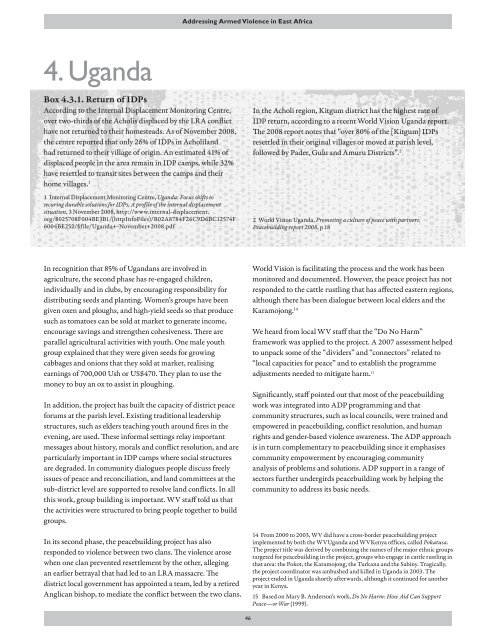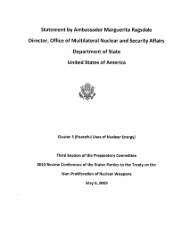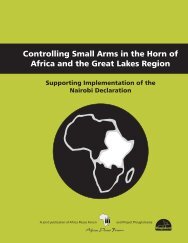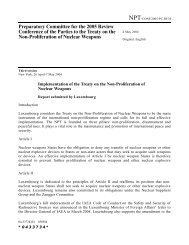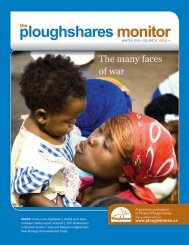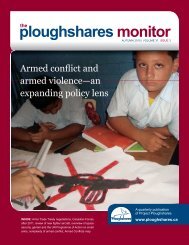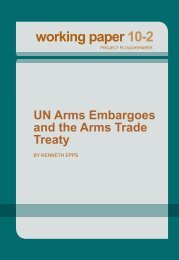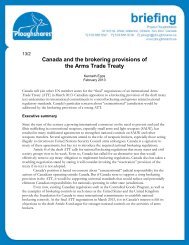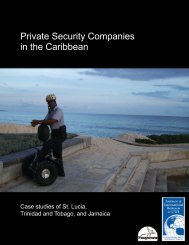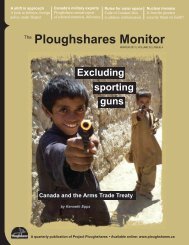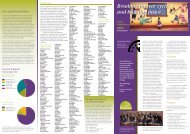Addressing Armed Violence in East Africa.pdf - Project Ploughshares
Addressing Armed Violence in East Africa.pdf - Project Ploughshares
Addressing Armed Violence in East Africa.pdf - Project Ploughshares
You also want an ePaper? Increase the reach of your titles
YUMPU automatically turns print PDFs into web optimized ePapers that Google loves.
<strong>Address<strong>in</strong>g</strong> <strong>Armed</strong> <strong>Violence</strong> <strong>in</strong> <strong>East</strong> <strong>Africa</strong>4. UgandaBox 4.3.1. Return of IDPsAccord<strong>in</strong>g to the Internal Displacement Monitor<strong>in</strong>g Centre,over two-thirds of the Acholis displaced by the LRA conflicthave not returned to their homesteads. As of November 2008,the centre reported that only 26% of IDPs <strong>in</strong> Acholilandhad returned to their village of orig<strong>in</strong>. An estimated 41% ofdisplaced people <strong>in</strong> the area rema<strong>in</strong> <strong>in</strong> IDP camps, while 32%have resettled to transit sites between the camps and theirhome villages. 11 Internal Displacement Monitor<strong>in</strong>g Centre, Uganda: Focus shifts tosecur<strong>in</strong>g durable solutions for IDPs, A profile of the <strong>in</strong>ternal displacementsituation, 3 November 2008, http://www.<strong>in</strong>ternal-displacement.org/8025708F004BE3B1/(httpInfoFiles)/B02A8784F26C9D6BC12574F6004BE252/$file/Uganda+-November+2008.<strong>pdf</strong>In the Acholi region, Kitgum district has the highest rate ofIDP return, accord<strong>in</strong>g to a recent World Vision Uganda report.The 2008 report notes that “over 80% of the [Kitgum] IDPsresettled <strong>in</strong> their orig<strong>in</strong>al villages or moved at parish level,followed by Pader, Gulu and Amuru Districts”. 22 World Vision Uganda, Promot<strong>in</strong>g a culture of peace with partners:Peacebuild<strong>in</strong>g report 2008, p 18In recognition that 85% of Ugandans are <strong>in</strong>volved <strong>in</strong>agriculture, the second phase has re-engaged children,<strong>in</strong>dividually and <strong>in</strong> clubs, by encourag<strong>in</strong>g responsibility fordistribut<strong>in</strong>g seeds and plant<strong>in</strong>g. Women’s groups have beengiven oxen and ploughs, and high-yield seeds so that producesuch as tomatoes can be sold at market to generate <strong>in</strong>come,encourage sav<strong>in</strong>gs and strengthen cohesiveness. There areparallel agricultural activities with youth. One male youthgroup expla<strong>in</strong>ed that they were given seeds for grow<strong>in</strong>gcabbages and onions that they sold at market, realis<strong>in</strong>gearn<strong>in</strong>gs of 700,000 Ush or US$470. They plan to use themoney to buy an ox to assist <strong>in</strong> plough<strong>in</strong>g.In addition, the project has built the capacity of district peaceforums at the parish level. Exist<strong>in</strong>g traditional leadershipstructures, such as elders teach<strong>in</strong>g youth around fires <strong>in</strong> theeven<strong>in</strong>g, are used. These <strong>in</strong>formal sett<strong>in</strong>gs relay importantmessages about history, morals and conflict resolution, and areparticularly important <strong>in</strong> IDP camps where social structuresare degraded. In community dialogues people discuss freelyissues of peace and reconciliation, and land committees at thesub-district level are supported to resolve land conflicts. In allthis work, group build<strong>in</strong>g is important. WV staff told us thatthe activities were structured to br<strong>in</strong>g people together to buildgroups.In its second phase, the peacebuild<strong>in</strong>g project has alsoresponded to violence between two clans. The violence arosewhen one clan prevented resettlement by the other, alleg<strong>in</strong>gan earlier betrayal that had led to an LRA massacre. Thedistrict local government has appo<strong>in</strong>ted a team, led by a retiredAnglican bishop, to mediate the conflict between the two clans.World Vision is facilitat<strong>in</strong>g the process and the work has beenmonitored and documented. However, the peace project has notresponded to the cattle rustl<strong>in</strong>g that has affected eastern regions,although there has been dialogue between local elders and theKaramojong. 14We heard from local WV staff that the “Do No Harm”framework was applied to the project. A 2007 assessment helpedto unpack some of the “dividers” and “connectors” related to“local capacities for peace” and to establish the programmeadjustments needed to mitigate harm. 15Significantly, staff po<strong>in</strong>ted out that most of the peacebuild<strong>in</strong>gwork was <strong>in</strong>tegrated <strong>in</strong>to ADP programm<strong>in</strong>g and thatcommunity structures, such as local councils, were tra<strong>in</strong>ed andempowered <strong>in</strong> peacebuild<strong>in</strong>g, conflict resolution, and humanrights and gender-based violence awareness. The ADP approachis <strong>in</strong> turn complementary to peacebuild<strong>in</strong>g s<strong>in</strong>ce it emphasisescommunity empowerment by encourag<strong>in</strong>g communityanalysis of problems and solutions. ADP support <strong>in</strong> a range ofsectors further undergirds peacebuild<strong>in</strong>g work by help<strong>in</strong>g thecommunity to address its basic needs.14 From 2000 to 2003, WV did have a cross-border peacebuild<strong>in</strong>g projectimplemented by both the WVUganda and WVKenya offices, called Pokatusa.The project title was derived by comb<strong>in</strong><strong>in</strong>g the names of the major ethnic groupstargeted for peacebuild<strong>in</strong>g <strong>in</strong> the project, groups who engage <strong>in</strong> cattle rustl<strong>in</strong>g <strong>in</strong>that area: the Pokot, the Karamojong, the Turkana and the Sab<strong>in</strong>y. Tragically,the project coord<strong>in</strong>ator was ambushed and killed <strong>in</strong> Uganda <strong>in</strong> 2003. Theproject ended <strong>in</strong> Uganda shortly afterwards, although it cont<strong>in</strong>ued for anotheryear <strong>in</strong> Kenya.15 Based on Mary B. Anderson’s work, Do No Harm: How Aid Can SupportPeace—or War (1999).46


